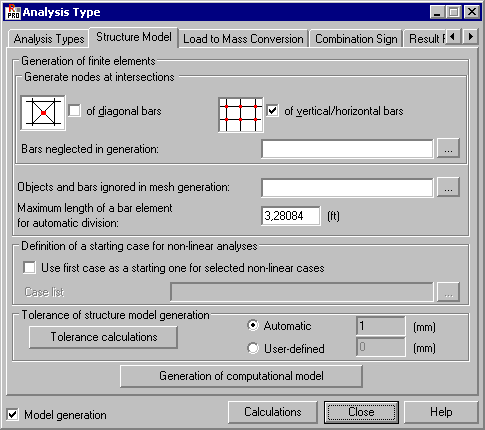Select Analysis > Analysis Types and then Model Generation to enable the Structure Model tab.

The following options are available:
- Node Generation at Intersection of Diagonals - An additional node will be created at the intersection of sloping bars.
- Node Generation at Intersection of Vertical/Horizontal Bars - An additional node will be created at the intersection of vertical and horizontal bars.
- List of bars that are to be skipped during node generation at points of bar intersections (an additional node will not be generated at the point of bar intersection).
- List of geometrical objects that are to be skipped during structure model generation.
- Lines, polylines, contours.
- Arcs, circles.
Skipped geometrical objects are not taken into account during generation of an element mesh. The finite element mesh will generate as if the structure project did not include the indicated objects. This is useful during the definition of moving loads. If a regular mesh is not to be affected by a vehicle route (polylines, lines or a contour along which the vehicle moves) it is enough to add the route number to the list of objects skipped during model generation.
The Maximum element length is used to determine a number of finite element divisions for the following analysis types:
- Buckling deformation - A selected buckling mode is considered as a structure initial defomation. Therefore, bars are divided into smaller elements to obtain a closer approximation of a deformed structure shape.
- Geometrical imperfections - Structure initial deformation is user defined by means of deflection in a bar center. Bar division allows approximation of a structure deformation.
- Elasto-plastic material - Analysis including a non-linear material property. Calculations are performed for element internal points according to the determined division.
Division is applied with respect to bar finite elements (a bar is divided by means of nodes). For the analysis types listed, element division into 5 parts is assumed by default. If the total element length is divided by the maximum defined length and the result is greater than 5, then the greater division number is adopted.
Definition of a starting case for non-linear analysis takes account of results of the first case as the beginner, starting states of loads, displacements and stress for selected analysis cases. Select Use first case as a starting one for selected non-linear cases to account for a starting case. A starting case is always the first case on the list according to the user defined case numbering. Please note, a modal analysis case may not be a starting case. If a starting case is auxiliary, then it will be calculated irrespective of its auxiliary case status.
A starting case associated with auxiliary cases and combinations is not taken into account in combinations defined using such cases or combinations; whereas a non-linear case associated with a starting case and used in a combination causes the starting case to be included in the combination.
A combination associated with a starting case causes results in the non-linear analysis of this case to be considered as a starting state for further analysis. Loads for which further analysis is performed no longer include components of a starting case.The exception being situations when it occurs as a combination component. Loads not considered in the first step of the analysis (the difference between a value of the factor used and 1.0) are taken into account.
If a structure includes cable elements, a first case is always treated as a starting one for all the remaining cases, regardless of the state of the Use first case as a starting one for selected non-linear cases option. For cable elements, a starting case is considered as an assembling case used for the prestress of cables.
Case list is intended for entering the numbers of the cases for which the initial state of the starting case will be taken into account. Click (...) to define cases through the Selection dialog.
A starting case should be applied for cases and combinations of non-linear analysis. In the case of linear analysis, it is ignored.Such a case should be included in a regular case combination.
A starting case is ignored in the following case types:
- Linear-static analysis - Simple cases and combinations.
- Time history analysis.
- Push-over analysis.
- Dynamic analysis, such as modal, seismic, spectral and harmonic analyses.
A starting case may be taken into account for a non-linear combination of cases. It is considered if at least one of the combination components includes the starting case. However, it does not refer to situations when an auxiliary case or another combination with an assigned starting case is a combination component.
In the Tolerance of Structure Model Generation field, click the Tolerance calculations button to determine the precision of structure definition (default 1mm; if the precision is smaller than 1mm, the calculated value is displayed). A 1mm standard value of tolerance is assumed by default, but you can define a tolerance value.
Click Generation of computational model to create a structure model. Bar-type or planar finite elements as well as intersections of bars or bars and planar finite elements will be generated depending on which options are checked in the dialog.